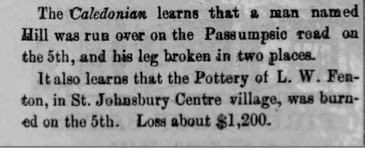Every time I pass a brick house in the Northeast Kingdom of Vermont, I'm reminded that these long-lasting house components came directly from the soil here. My understanding is that brickyards were once common in the region, especially along the streams and rivers, where clay beds could be found.
But it wasn't only bricks that came from such clay. Pottery, a classic of early American life, is formed from this specially elastic material, which can be shaped and then baked at high temperature in a kiln, to form waterproof containers. According to St. Johnsbury historian Edward Fairbanks, the products of the St. Johnsbury Stone Ware Pottery "were in constant demand until the introduction of tinware."
Studying the history of the Center Village, known today as St. Johnsbury Center, took me seeking the history of this pottery. "Early New England Potters and Their Wares" by Lura Woodside Watkins fills in the details that Fairbanks mentions in his history.
General (probably a militia title, perhaps from our Revolution) Richard Webber Fenton founded his stoneware manufactory about half a mile south of the village, on the west side of the river. His son Leander W. Fenton seems to have taken on the business and partnered with someone named Hancock; the "domestic ware" ("from jugs, jars, bottles and milk pans, at a dollar a dozen, to fancy flower pots at sixty cents each," wrote Fairbanks) were marked either "L. W. Fenton" or "Fenton & Hancock," along with the town's name. Power for the pottery, with its spinning potters' wheels, came from a brook spilling down the slope.
Watkins wrote that a great-granddaughter of Leander's, Mrs. W. W. Husband, lived in St. Johnsbury and had a list of the articles available in the late 1850s:
Both Fairbanks and Watkins mention the end of the pottery firm in November 1859, when a fire destroyed it. While working on my recent article on St. Johnsbury Center history for the October 2021 North Star Monthly, I found mention of the fire in the Caledonian, reprinted in the November 17, 1859, edition of the Green-Mountain Freeman:
I don't know of any items from this potterymaker locally, although Watkins enthuses about a distinctive one of the water coolers, with cobalt blue decorations that she guesses might have been done by either Eleazar Orcutt or Edward Alonzo Crafts, both known to have been employed in St. Johnsbury.
Jugs with the Fenton & Hancock mark come up at antique auctions fairly often, and I have borrowed an image from one of these to show above. Look closely and you can see part of the name of the pottery across the top of the blue decoration.






1 comment:
Hi Beth
Can I get an email address for you? I have a small collection of St Johnsbury stoneware I inherited from my mother Virginia. I would love to chat about the Fenton works and collecting these treasures. Peter Downs. peter@newwoodco.com
Post a Comment